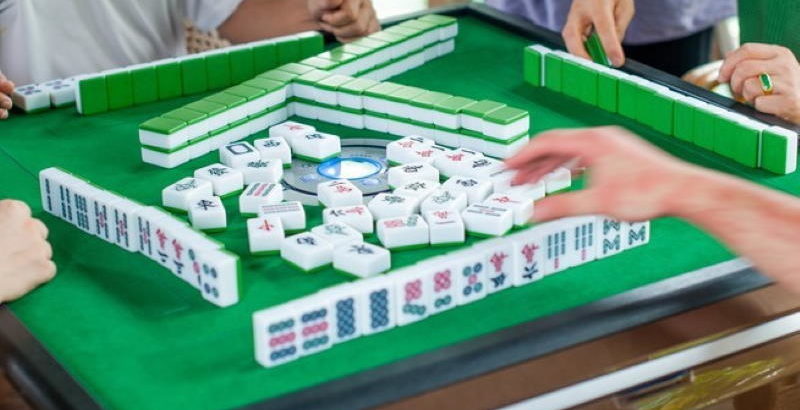These are the steps for setting up a standard Hong Kong (or Singapore) Mahjong game board.
Setting the Prevailing Wind and Game Wind
To determine the Player Game Wind, each player throws three dice (two in some variants) and the player with the highest total is chosen as the dealer or the banker. The dealer’s Wind is now East, the player to the right of the dealer has South wind, the next player to the right has West and the fourth player has North. Game Wind changes after every round, unless the dealer wins.
In some variations, the longer the dealer remains as the dealer, the higher the value of each hand.
The Prevailing Wind is always set to East when starting. It changes after the Game Wind has rotated around the board, that is, after each player has lost as the dealer.
A Mahjong set with Winds in play will usually include a separate Prevailing Wind marker (typically a die marked with the Wind characters in a holder) and a pointer that can be oriented towards the dealer to show Player Game Wind.
In sets with racks, a rack may be marked differently to denote the dealer. These winds are also significant as winds are often associated with a member of a Flower tile group; typically 1 with East, 2 with South, 3 with West, and 4 with North.
Dealing Mahjong Tiles
All tiles are placed face down and shuffled.
The dealing process that follows is ritualized and complex to prevent cheating. (But casual players, or players with Mahjong playing cards, may wish to simply shuffle well and deal out the tiles with fewer ceremonial procedures.)
Process of dealing
Each player stacks a row of tiles two deep in front of him, the length of the row depending on the number of tiles in use:
- 136 tiles: 17 tiles for all players
- 144 tiles: 18 tiles for all players
- 148 tiles: 19 tiles for dealer and player opposite, 18 for rest
- 152 tiles: 19 tiles for all players
The dealer then throws three dice and sums up the total. Counting counterclockwise so that the dealer is ‘1’, a player’s row is chosen. Starting at the right edge, ‘sum’ tiles are counted and shifted to the right.
The dealer now takes a block of 4 tiles to the left of the divide.
The player to the dealer’s right takes 4 tiles to the left, and players (counterclockwise) take blocks of 4 tiles (clockwise) until all players have 12 tiles for 13-tile variations and 16 for 16-tile variations. In 13-tile variations, each player then takes one more tile to make a 13-tile hand. In practice, in order to speed up the dealing procedure, the dealer often takes one extra tile during the dealing procedure to start their turn.
The board is now ready and new tiles will be taken from the wall where the dealing left off, proceeding clockwise. In some special cases, tiles are taken from the other end of the wall, commonly referred to as the back end of the wall. In some variations, a group of tiles at the back end, known as the dead wall, is reserved for this purpose instead. In such variations, the dead wall may be visually separated from the main wall, but it is not required.
Unless the dealer has already won, the dealer then discards a tile.
Charleston
In the American variations, it is required that before each hand begins, a Charleston is enacted. This consists of a procedure where three tiles are passed to the player on one’s right, followed by three tiles passed to the player opposite, followed by three tiles passed to the left.
The dealer can demand for a second Charleston, followed by an optional pass to the player across of one, two or three tiles. This is a distinctive feature of American Mahjong that may have been borrowed from card games.

